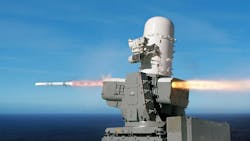Navy asks L3Harris to integrate electro-optical sensors for ship self-defense against cruise missiles
WASHINGTON – Shipboard electronics systems integrators at L3Harris Technologies will design and build a wide-field-of-view electro-optical system to help protect surface warships from advanced enemy anti-ship cruise missiles under terms of a potential half-billion-dollar contract announced Tuesday.
Officials of the Naval Sea Systems Command in Washington announced a $205.9 million contract to the L3Harris C5 Integrated Systems segment in Camden, N.J., to develop shipboard electro-optical sensors technologies as part of the Shipboard Panoramic Electro-Optic/Infrared (SPEIR) program.
The contract has options that could increase its value to $593.1 million, and extend the duration of the contract to March 2031. The contract involves integrating technologies in visible-light cameras, infrared sensors, and laser-based sensors such as laser rangefinders and light direction and finding (lidar) systems.
Related: Raytheon to provide electro-optical cruise missile defense
SPEIR seeks to field an integrated narrow- and wide-field-of-view detection and cueing capability for anti-ship cruise missile defense, to counter-fast attack craft and fast inshore attack craft, counter-unmanned aerial vehicles (UAVs), enhance mobility, and to conduct anti-terrorist and force-protection operations.
SPEIR focuses on speeding the fielding of advanced electro-optical and infrared capability to provide passive surveillance, detection, and weapons cueing for the Navy surface warship fleet. The system initially is for Arleigh-Burke-class destroyers, Ticonderoga-class cruisers, and future Constellation-class frigates.
The ship self-defense program has an incremental approach for increasing capability as electro-optical technologies continues to mature, Navy officials say. SPEIR seeks to capitalize on proven mature electro-optical technologies to help defend Navy surface warships from a wide variety of enemy threats.
Related: L3Harris to build electro-optical gun sights for Navy ships
SPEIR will deliver systems to the fleet as quickly and affordably as possible, and provide modularity where it makes sense for future capability enhancements, Navy officials say.
On this contract L3Harris will do the work in Mason, Ohio; Northampton, Mass.; Bothell, Wash.; Hamilton, Ontario; Austin, Texas; Tulsa, Okla.; Norfolk, Va.; and other U.S. locations, and should be finished by November 2025.
For more information contact L3Harris online at www.l3harris.com, or Naval Sea Systems Command at www.navsea.navy.mil.

John Keller | Editor-in-Chief
John Keller is the Editor-in-Chief, Military & Aerospace Electronics Magazine--provides extensive coverage and analysis of enabling electronics and optoelectronic technologies in military, space and commercial aviation applications. John has been a member of the Military & Aerospace Electronics staff since 1989 and chief editor since 1995.

